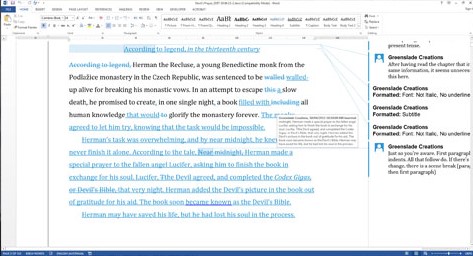The main types of book editing we undertake at PMBO are:
Proofreading

Proofreading eliminates errors and includes fixing a variety of common issues specific to different genres. For fiction, these may include such things as correcting point of view and dialogue. Tor non-fiction, it may include things such as abbreviations and references, abstracts, referencing, brackets, dates, numerical lists, quotations and reference lists.
In both fiction and non-fiction, proofreading corrects universal errors including abbreviations and contractions, alternative spellings, capitalisation, italics, titles, spelling and punctuation—inclusive of apostrophes, colons, commons, dashes, ellipses, hyphenation and periods.
Proofreading is usually the last stage of the editing process and takes place once you have completed your final draft. Sometimes it is done after layout, but bear in mind that this workflow will cause extra work for your typesetter.
Proofreading is completed in Microsoft Word using the track changes function. This allows the editor to apply changes, and comment on any errors that exist within the text. Then you, as the writer, can accept or reject the changes as you wish.
Line editing

Line editing involves a combination of proofreading/copyediting as well as cohesion and flow (big picture) editing, where the editor carefully reviews each word, sentence and paragraph. The editor analyses the text for both simple and complex issues. For fiction, these may include improvements needed to enhance the structure, plot and characters. For both fiction and non-fiction, a line editor will look at the overall text and correct inconsistencies.
Above all, the editor makes changes and suggestions that ensure the book delivers on its purpose as you intended it to. Not all editors and proofreaders are capable at line editing. Some are really only able to proofread. If you can find a good editor for your book stick with them. Their familiarity with your style and genre will make it easier for you to work with them. The quality of their suggestions and the thoroughness of their ability to notice mistakes varies from editor to editor.
Some editors will not rewrite or introduce new creative elements of a fiction piece, for example. If you are looking for an editor that can do this, or you are not sure, always ask for a sample edit (sample of your work edited free of charge). That way you can decide if this is the right editor for you.
Here at PMBO we offer a free sample edit (e.g. a series of paragraphs) as long as your total word count is at least 30,000 words. Contact us.
Heavy editing and rewriting

A heavy edit usually involves intricate editing and rewriting for a particular genre of book, whether it is fiction or non-fiction. Indeed there is a fine line between a heavy edit (rewrite) and ghost-writing, with the former generally being based on existing text, and the latter being created from notes, interviews or from scratch by the ghost-writer.
As with the other forms of editing, heavy editing and rewriting utilise the track changes function of Microsoft® Word™, so the writer can consider the changes suggested by the editor and accept and reject them as they see fit. There will also be comments on the side of the manuscript with questions or changes that the editor feels the writer needs to decide upon and then carry out.
Heavy editing and rewriting may occur after an initial manuscript assessment has taken place. It may be the best form of editing to help an inexperienced writer.
Comprehensive editing for books
A comprehensive edit is a phrase that describes a project, not a type of editing as such. It involves many rounds of editing inclusive of different types as needed depending on the manuscript. For example, a novel might need a structural edit, then a line edit followed by proofreading. In between each, the writer does more work on the manuscript as per the editor’s suggestions.
Structural editing

Structural editing assesses big picture issues. The editor analyses everything from whether a non-fiction text delivers the information it promised, to whether the plot in a fiction text is engaging enough to keep a reader turning the page. The editor reads the entire text and may rearrange passages, suggest deletions and general changes, such as rewording, to enhance the book’s readability.
A structural editor of a book does not usually use track changes, as that sort of detailed editing is only done during line editing, proofreading or heavy editing. Rather, a structural editor provides a detailed report for the writer. The structural edit usually occurs instead of a manuscript assessment.
Manuscript assessment
Manuscript assessment involves assessing the overall status of the manuscript to determine its viability in the marketplace. Perhaps, more importantly, the assessment provides the writer with actionable feedback that can serve as a new starting point as they continue to develop their manuscript, perhaps by taking it in a different direction.
It is the first step a writer may take once they have completed their text, or even perhaps once they have completed part of their text (we call this a mini-manuscript assessment). Following a manuscript assessment, the writer may choose to implement the feedback and proceed to further stages of editing.
Find out more about our editing services